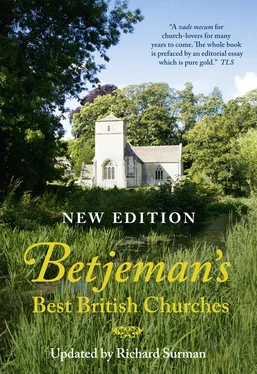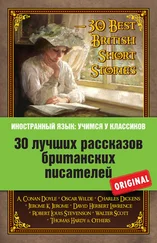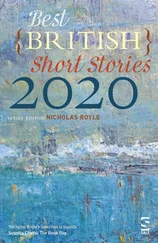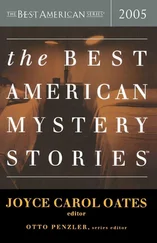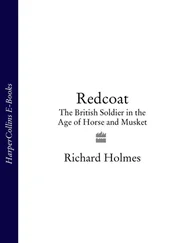This new version – Betjeman’s Best British Churches – takes Betjeman’s original idea and moves it in a slightly different direction, but with great respect for his fundamental love of parish churches. The volume has much of a 21st-century feel about it – the age of satellite navigation and precision mapping have allowed us to create very precise locations for each of the churches featured herein. Betjeman would have found this odd, I’m sure, but it is our hope that in ‘modernising’ the format of the book, we might appeal to a new audience more familiar with the digital age, as well as re-invigorating those familiar with earlier versions.
There are three radical departures from previous editions. The first is that we have introduced a much stronger pictorial element: full colour photographs are used throughout the book, as are accurate and clear maps of each county. The second radical difference arises from the first: with a large number of colour illustrations, the extent of the book has had to be considerably reduced. Betjeman’s original book contained some 4,500 entries, and in some respects was a gazetteer. We decided to considerably modify this present edition, cutting down to some 2,500 entries. The criterion for retaining entries has been, wherever possible, to refer to the very simple star system that Betjeman employed in the 1968 edition, as the basis for first selection. Although the most recent 1993 edition discarded this form of rating, we have re-introduced it here, refining it so that throughout the book there is now a one- and two-star rating. Naturally there are many other churches included that were not starred in Betjeman’s 1968 edition – some of those have been revised too. There are also new churches included, and to these we have applied rating criteria that reflect those of which Betjeman would have approved.
The third radical departure from previous versions is the creation of an entirely new section for Scotland. Though Scottish religious history differs quite significantly from that of England and Wales, we believe that there is a sufficient number of fine churches in Scotland to merit a place alongside their English and Welsh counterparts.
Another distinct feature of this present book is the inclusion of several notable Roman Catholic churches: these have been selected as being of outstanding historical, architectural or artistic merit. The medieval abbey of Pluscarden in Scotland qualifies on both counts, first as the only medieval monastery in the British Isles in continuous use – barring a hiatus after the Reformation – by a Roman Catholic monastic community, and second as a centre of design and production of outstanding contemporary glass. The Church of the Immaculate Conception, Farm Street, London has an entry, based on the excellent work of A. W. N. Pugin to the altar and reredos and the chancel chapels by H. Clutton and J. F. Bentley. London’s Brompton Oratory gets an entry too; it would be remiss to ignore this extraordinary piece of Rome in London. In common with earlier editions we have also included churches in the care of the excellent Churches Conservation Trust, the Friends of Friendless Churches – especially in Wales – and English Heritage.
As regards the structure of counties, we have followed all the modern ceremonial boundaries: this has necessitated a considerable re-ordering of Yorkshire, the merging of Westmorland and Cumberland into Cumbria, changes to Berkshire and Oxfordshire and several other counties. Rutland, the country’s smallest and fiercely independent county, has been retained, whilst Huntingdonshire and the Soke of Peterborough have been brought together within Cambridgeshire. Bristol is with Somerset, and London is in two parts, Central and Greater London (the latter containing Middlesex and the inner parts of Essex, Kent and Surrey). Greater Manchester and Merseyside are together with Lancashire.
Considerable effort has gone into checking the facts about each entry, and wherever possible we have corrected errors. For errors that we have inadvertently introduced or have failed to correct, we both apologise and welcome comments.
To those people who may be disconcerted by the disappearance from this edition of their familiar churches, we ask for their forbearance, and hope that we have explained with sufficient persuasion the reasons why. Above all what we have striven to achieve is a book that captures the spirit of the earlier editions, in a 21st-century context.
A book such as this is not possible without the work of many people, not least those who have contributed to the various counties over the years. In particular I would like to thank Sam Richardson and Helena Nicholls at Collins Reference for their enthusiastic support for a long and complex project. I would also like to express my gratitude to Mike and Ros Ellis at Thameside Media: their hard and painstaking work on the planning, design, mapping, checking and photography have been essential. Their enthusiasm and expertise has taken them, I suspect, way beyond their brief. I am also very grateful to Michael Lynch, former Sir William Fraser Professor of Scottish History and Palaeography, for his eagle-eyed and helpful observations on my attempts to disentangle Scottish religious history.
Many others have contributed more indirectly – those hard-working souls that keep (some) of our fine churches open, that write the individual church guides, many of which are of a very high standard, and the various organisations, particularly the Churches Conservation Trust, the Friends of Friendless Churches, the National Churches Trust and the many county historic church trusts, all of whom work tirelessly to preserve a priceless heritage – the parish church.
Richard Surman 2011

WALPOLE ST PETER: ST PETER – the porch to the church is vaulted in a beautiful sandstone, the bosses sculpted into the sleeping forms of foals, sheep and suchlike
© Michael Ellis
INTRODUCTION by Sir John Betjeman
PART ONE: THE OLD CHURCHES
To atheists inadequately developed building sites; and often, alas, to Anglicans but visible symbols of disagreement with the incumbent: ‘the man there is “too high”, “too low”, “too lazy”, “too interfering”’ – still they stand, the churches of England, their towers grey above billowy globes of elm trees, the red cross of St George flying over their battlements, the Duplex Envelope System employed for collections, schoolmistress at the organ, incumbent in the chancel, scattered worshippers in the nave, Tortoise stove slowly consuming its ration as the familiar 17th-century phrases come echoing down arcades of ancient stone.
Odi et amo. This sums up the general opinion of the Church of England among the few who are not apathetic. One bright autumn morning I visited the church of the little silver limestone town of Somerton in Somerset. Hanging midway from a rich-timbered roof, on chains from which were suspended branched and brassy-gleaming chandeliers, were oval boards painted black. In gold letters on each these words were inscribed:
TO GOD’S
GLORY
&
THE HONOR OF
THE
CHURCH OF
ENGLAND
1782
They served me as an inspiration towards compiling this book.
The Parish Churches of England are even more varied than the landscape. The tall town church, smelling of furniture polish and hot-water pipes, a shadow of the medieval marvel it once was, so assiduously have Victorian and even later restorers renewed everything old; the little weather-beaten hamlet church standing in a farmyard down a narrow lane, bat-droppings over the pews and one service a month; the church of a once prosperous village, a relic of the 15th-century wool trade, whose soaring splendour of stone and glass subsequent generations have had neither the energy nor the money to destroy; the suburban church with Northamptonshire-style steeple rising unexpectedly above slate roofs of London and calling with mid-Victorian bells to the ghosts on the edge of the industrial estate; the High, the Low, the Central churches, the alive and the dead ones, the churches that are easy to pray in and those that are not, the churches whose architecture brings you to your knees, the churches whose decorations affront the sight – all these come within the wide embrace of our Anglican Church, whose arms extend beyond the seas to many fabrics more.
Читать дальше
